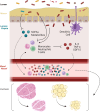Involvement of the gut microbiota in cancer cachexia
- PMID: 38981609
- PMCID: PMC11427007
- DOI: 10.1152/ajpcell.00327.2024
Involvement of the gut microbiota in cancer cachexia
Abstract
Cancer cachexia, or the unintentional loss of body weight in patients with cancer, is a multiorgan and multifactorial syndrome with a complex and largely unknown etiology; however, metabolic dysfunction and inflammation remain hallmarks of cancer-associated wasting. Although cachexia manifests with muscle and adipose tissue loss, perturbations to the gastrointestinal tract may serve as the frontline for both impaired nutrient absorption and immune-activating gut dysbiosis. Investigations into the gut microbiota have exploded within the past two decades, demonstrating multiple gut-tissue axes; however, the link between adipose and skeletal muscle wasting and the gut microbiota with cancer is only beginning to be understood. Furthermore, the most used anticancer drugs (e.g. chemotherapy and immune checkpoint inhibitors) negatively impact gut homeostasis, potentially exacerbating wasting and contributing to poor patient outcomes and survival. In this review, we 1) highlight our current understanding of the microbial changes that occur with cachexia, 2) discuss how microbial changes may contribute to adipose and skeletal muscle wasting, and 3) outline study design considerations needed when examining the role of the microbiota in cancer-induced cachexia.
Keywords: Bifidobacterium; Lactobacillus; inflammation; microbiome; wasting.
Conflict of interest statement
No conflicts of interest, financial or otherwise, are declared by the authors.
Figures



Similar articles
-
Understanding the gut microbiota in cancer cachexia.Curr Opin Clin Nutr Metab Care. 2023 Sep 1;26(5):482-489. doi: 10.1097/MCO.0000000000000957. Epub 2023 Jun 22. Curr Opin Clin Nutr Metab Care. 2023. PMID: 37389459 Review.
-
Prescription of Controlled Substances: Benefits and Risks.2025 Jul 6. In: StatPearls [Internet]. Treasure Island (FL): StatPearls Publishing; 2025 Jan–. 2025 Jul 6. In: StatPearls [Internet]. Treasure Island (FL): StatPearls Publishing; 2025 Jan–. PMID: 30726003 Free Books & Documents.
-
Role of the intestinal microbiota in contributing to weight disorders and associated comorbidities.Clin Microbiol Rev. 2024 Sep 12;37(3):e0004523. doi: 10.1128/cmr.00045-23. Epub 2024 Jun 28. Clin Microbiol Rev. 2024. PMID: 38940505 Free PMC article. Review.
-
Pectoralis major muscle atrophy is associated with mitochondrial energy wasting in cachectic patients with gastrointestinal cancer.J Cachexia Sarcopenia Muscle. 2022 Jun;13(3):1837-1849. doi: 10.1002/jcsm.12984. Epub 2022 Mar 22. J Cachexia Sarcopenia Muscle. 2022. PMID: 35316572 Free PMC article. Clinical Trial.
-
Ghrelin for the management of cachexia associated with cancer.Cochrane Database Syst Rev. 2018 Feb 28;2(2):CD012229. doi: 10.1002/14651858.CD012229.pub2. Cochrane Database Syst Rev. 2018. PMID: 29489032 Free PMC article.
Cited by
-
Transcriptional analysis of cancer cachexia: conserved and unique features across preclinical models and biological sex.Am J Physiol Cell Physiol. 2024 Dec 1;327(6):C1514-C1531. doi: 10.1152/ajpcell.00647.2024. Epub 2024 Oct 28. Am J Physiol Cell Physiol. 2024. PMID: 39466180
-
Modulating the Gut-Muscle Axis: Increasing SCFA-Producing Gut Microbiota Commensals and Decreasing Endotoxin Production to Mitigate Cancer Cachexia.Microorganisms. 2025 Jun 11;13(6):1356. doi: 10.3390/microorganisms13061356. Microorganisms. 2025. PMID: 40572244 Free PMC article. Review.
-
Advancements and future directions in American Journal of Physiology-Cell Physiology: a 2024 editorial update.Am J Physiol Cell Physiol. 2024 Dec 1;327(6):C1681-C1685. doi: 10.1152/ajpcell.00862.2024. Am J Physiol Cell Physiol. 2024. PMID: 39651915 No abstract available.
-
Metabolic, Inflammatory, and Molecular Impact of Cancer Cachexia on the Liver.Int J Mol Sci. 2024 Nov 7;25(22):11945. doi: 10.3390/ijms252211945. Int J Mol Sci. 2024. PMID: 39596015 Free PMC article. Review.
-
Bridging the tumor microenvironment: the pivotal role of cancer-associated fibroblasts in tumor cachexia development.Mol Cancer. 2025 Jul 14;24(1):194. doi: 10.1186/s12943-025-02379-7. Mol Cancer. 2025. PMID: 40660208 Free PMC article. Review.
References
-
- Fearon K, Strasser F, Anker SD, Bosaeus I, Bruera E, Fainsinger RL, Jatoi A, Loprinzi C, MacDonald N, Mantovani G, Davis M, Muscaritoli M, Ottery F, Radbruch L, Ravasco P, Walsh D, Wilcock A, Kaasa S, Baracos VE. Definition and classification of cancer cachexia: an international consensus. Lancet Oncol 12: 489–495, 2011. doi: 10.1016/S1470-2045(10)70218-7. - DOI - PubMed
-
- Anker MS, Holcomb R, Muscaritoli M, von Haehling S, Haverkamp W, Jatoi A, Morley JE, Strasser F, Landmesser U, Coats AJS, Anker SD. Orphan disease status of cancer cachexia in the USA and in the European Union: a systematic review. J Cachexia Sarcopenia Muscle 10: 22–34, 2019. doi: 10.1002/jcsm.12402. - DOI - PMC - PubMed
-
- Bindels LB, Neyrinck AM, Loumaye A, Catry E, Walgrave H, Cherbuy C, Leclercq S, Van Hul M, Plovier H, Pachikian B, Bermúdez-Humarán LG, Langella P, Cani PD, Thissen JP, Delzenne NM. Increased gut permeability in cancer cachexia: mechanisms and clinical relevance. Oncotarget 9: 18224–18238, 2018. doi: 10.18632/oncotarget.24804. - DOI - PMC - PubMed
-
- Ubachs J, Ziemons J, Soons Z, Aarnoutse R, van Dijk DPJ, Penders J, van Helvoort A, Smidt ML, Kruitwagen RFPM, Baade-Corpelijn L, Olde Damink SWM, Rensen SS. Gut microbiota and short-chain fatty acid alterations in cachectic cancer patients. JCSM 12: 2007–2021, 2021. doi: 10.1002/jcsm.12804. - DOI - PMC - PubMed
Publication types
MeSH terms
Grants and funding
LinkOut - more resources
Full Text Sources
Medical
Miscellaneous

